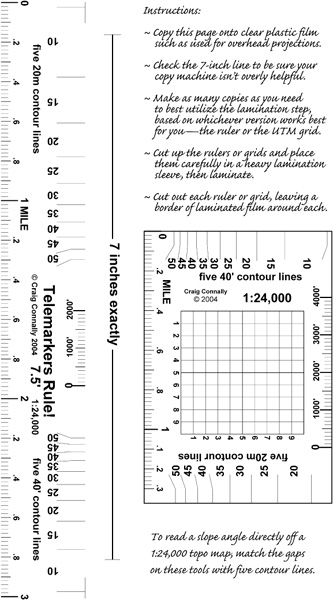
Some references include Internet links, which typically have only a fleeting existence. Conduct your own searches using a few keywords.
Cox, Steven M., and Kris Fulsaas, eds. Mountaineering: The Freedom of the Hills, 7th ed. Seattle: Mountaineers Books, 2003. The classic bible of old-school gear and methodology.
Field Manual FM 3-97.61: Military Mountaineering. Washington, D.C.: Department of the Army, 2002. All the same stuff as Freedom of the Hills, including weather, first aid, climbing, hazards, snow and ice—all solidly old-school. Even the illustrations are remarkably similar, except for the uniforms. Free on the Net at: http://155.217.58.58/cgi-bin/atdl.dll/fm/3-97.61/toc.htm or www.adtdl.army.mil/cgi-bin/atdl.dll/fm/3-97.61/toc.htm
Start exploring avalanche forecasts at the Colorado Avalanche Information Center’s page of links to many areas: http://www.geosurvey.state.co.us/avalanche/Link.html
Canadian avalanche forecasts may be found at: http://www.avalanche.ca/weather/bulletins/index.html
To learn more about high-altitude illness check The International Society of Mountain Medicine’s site at www.issmmed.org/np_altitude_tutorial.htm. Or read the standard reference for medical professionals: Hackett, Peter H., and Robert C. Roach, “Current Concepts: High-Altitude Illness” New England Journal of Medicine, 345 (2001):107–114.
Long, John. Close Calls: Climbing Mishaps and Near-Death Experiences. Helena, MT: Falcon Publishing, 1999. Learn from others’ mistakes and John Long’s advice.
Williamson, Jed, ed. Accidents in North American Mountaineering. Golden, CO: American Alpine Club and Alpine Club of Canada, annual editions.
To get started with more sophisticated weather forecasts, check out the National Weather Service’s Storm Prediction Center, Mesoscale Discussions, at www.spc.noaa.gov/products/md/. Much of this data is updated hourly. For all manner of weather information covering the United States (with links to Canada), start out at the NWS home page: www.nws.noaa.gov or for Western states, www.wrh.noaa.gov.
Petzl, innovative French climbing and caving equipment manufacturer’s product instruction sheets, catalogs, and Web site (www.petzl.com) are filled with sensible, up-to-date information and guidance. Plus, Petzl’s product names are très clever.
Klassen, Karl. Technical Handbook for Professional Mountain Guides: Alpine, Rock, and Ski Guiding Techniques. Kamloops, BC: Association of Canadian Mountain Guides, American Mountain Guide Association, 1999. Get it with your membership.
Long, John, and Bob Gaines. More Climbing Anchors. Guilford, CT: Falcon Press/Chockstone Press Books, 1996. Clear photos and old-school discussions of lots of complex anchors.
Chouinard, Yvon. Climbing Ice. San Francisco: Sierra Club Books, 1977. Classic, but not old-school, this is the real deal from the guy who engendered hard ice climbing while espousing fast and light.
For up-to-date information on fabrics and breathability, search the Net for “Elizabeth A. McCullough” and “Phil Gibson” + Natick.
Townsend, Chris. The Advanced Backpacker: A Handbook for Year-Round, Long-Distance Hiking. Camden, ME: Ragged Mountain Press, 2001. Excellent, clear, and practical advice for backpacking, especially over long distances.
Townsend, Chris. The Backpacker’s Handbook, 3rd ed. Camden, ME: Ragged Mountain Press, 2005.
O’Bannon, Allen, and Mike Clelland (illustrator). Allen and Mike’s Really Cool Backpackin’ Book: Traveling and Camping Skills for a Wilderness Experience. Helena, MT: Falcon Publishing, 2001. A great place to start, if a tad old-school in approach. You gotta love Clelland’s illustrations.
The following is a list of the chemicals used in various insect repellents. I offer them should you care to read the fine print on the containers you’re considering: The best repellents contain the chemicals DEET (N, N-diethyl-m-toluamide same as N, N-diethyl-3-methylbenzamide), Indalone (butyl 3,4-dihydro-2,2-dimethyl-4-oxo-2H-pyran-6-carboxylate), Rutgers 612 (2-ethyl-1,3-hexanediol), and DMP (dimethyl phthalate); DEET is probably the best choice. Di-n-propyl isocinchomeronate (R-326) has been promoted as useful against biting flies. MGK-264 is N-octyl bicycloheptene dicarboximide; it’s a synergistic agent for DEET. IBI-246 is 2-undecanone, a Category IV chemical used in cosmetics.
Connors, Christine. The Lip Smackin’ Backpackin’ Cookbook. Helena, MT: Falcon Publishing, 2000. This, and the following cookbooks, while highly recommended, are aimed at backpackers not mountaineers. Even though they feature the use of dehydrators, mountaineers may have to adapt the recipes for efficient preparation in alpine conditions. Still way better than freeze dry.
McHugh, Gretchen. Hungry Hikers Book of Good Cooking. New York: Alfred A. Knopf, 1982.
Fleming, June. The Well-Fed Backpacker, 3rd ed. New York: Vintage Books, 1986.
Marrone, Teresa. The Backcountry Kitchen. Sedona AZ: North Trail Press, 1996.
For more information on the science of vitamin supplementation and life extension, search the Net for Dr. “Bruce Ames.”
Hammer Nutrition, Ltd. Makers of Hammer Gel and other nutritionals for ultra endurance athletes, with an emphasis on cyclists. Check their J.O.E. for random scientific research. See www.e-caps.com.
Life Extension Foundation, a source of every possible health (not necessarily sports) supplement, reasonable prices, and tons of peer-reviewed research. See www.lef.org.
Various interactive ways to determine VO2max and fitness without medical tests: “Assessing Physical Fitness of Participants and Staff using Non-Exercise Screening Techniques,” Rich Curtis: www.outdoorsafety.org/articles/article.asp?ArticleID=144, based on Jackson, A. S., S. N. Blair, M. T. Mahar, L. T. Wier, R. M. Ross, and J. E. Stuteville, “Prediction of Functional Aerobic Capacity without Exercise Testing” Medicine and Science in Sport and Exercise 22(6) 1990: 863–870.
Isaac, Jeffrey. The Outward Bound Wilderness First-Aid Handbook. New York: Lyons Press, 1998. New-school wilderness first aid, up to the level of Wilderness Advanced First Aid.
Morrissey, Jim. Wilderness Medical Associates Field Guide. Colorado Springs: Wilderness Medical Associates, 2000. A tiny guide to the content of Wilderness Medical Associates’s excellent wilderness first-aid instruction; useless without the course. See www.wildmed.com
Check out the National Outdoor Leadership School (NOLS) Wilderness Medical Institute at www.nols.edu/wmi/.
Fasulo, David J. Self-Rescue. Guilford, CT: Falcon Press/Chockstone Press Books, 1999.
Tyson, Andy, and Mike Clelland (illustrator).
The Illustrated Guide to Glacier Travel and Crevasse Rescue. Carbondale, CO: Climbing Magazine Publications, 2000. A great example of a book that pretty much nails its subject dead-on.

Map tools for skiers and mountaineers.